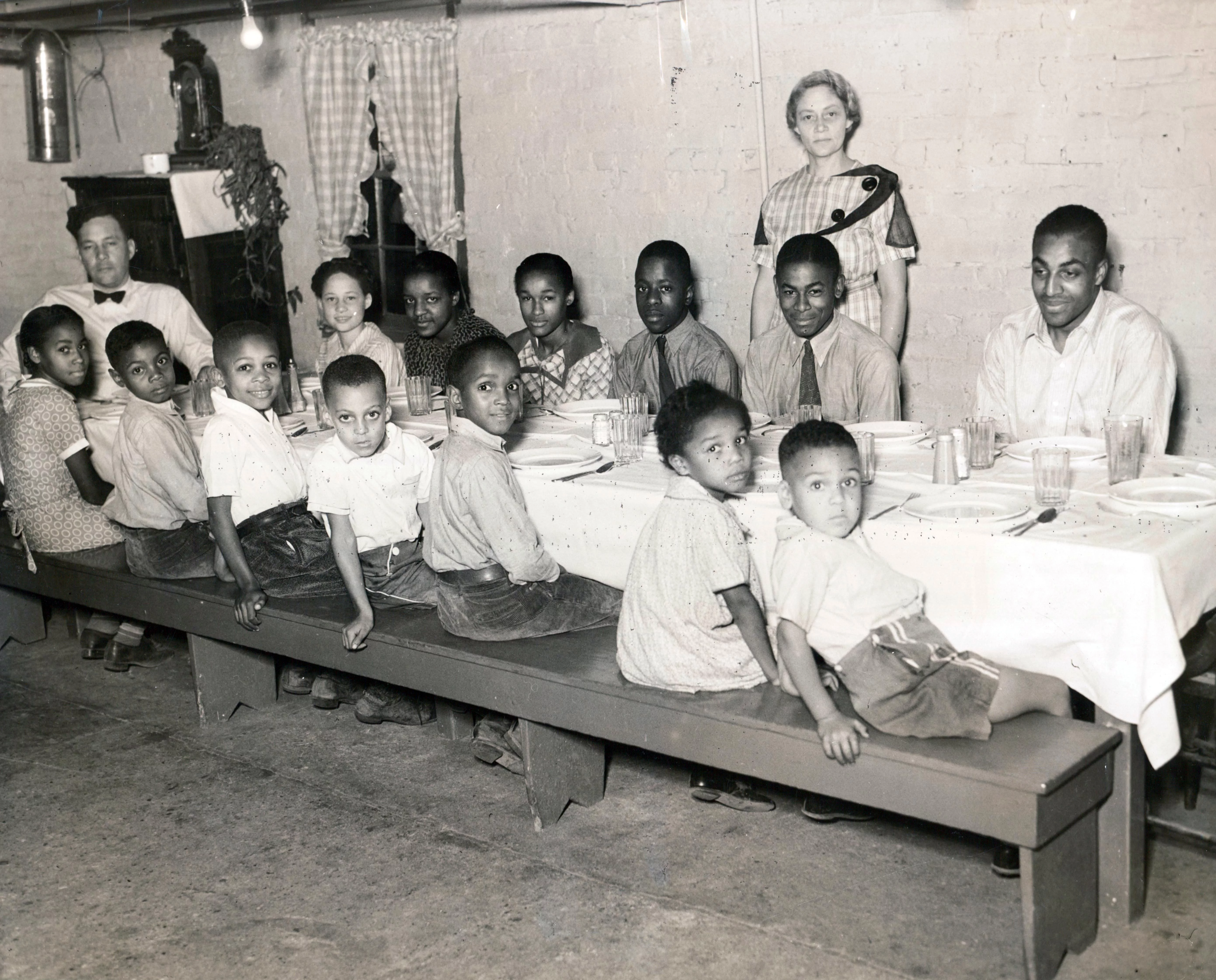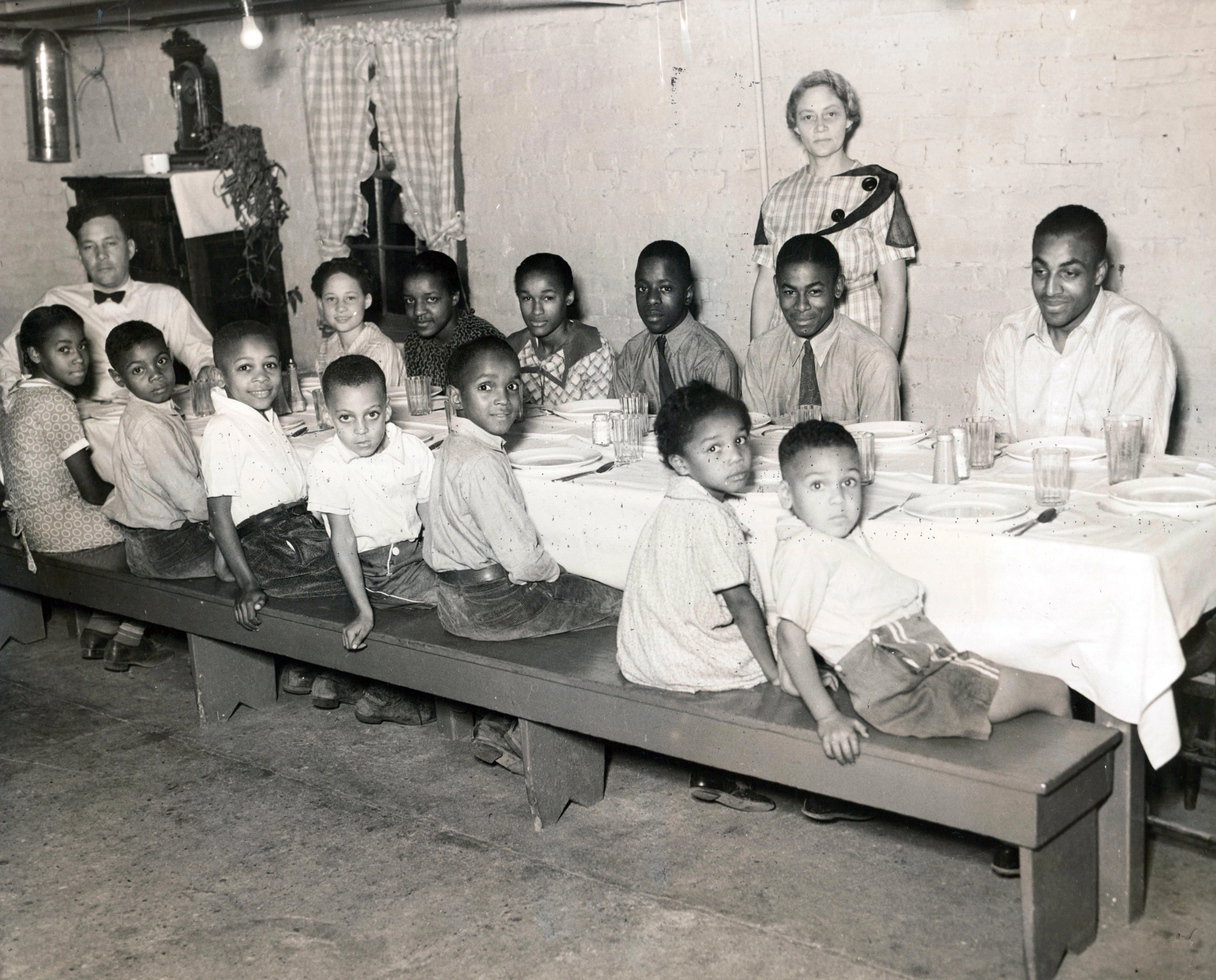“Cooks and counselors, painters and referees, they are also mom and pop to up to twenty children,” it was said of Louise and Napoleon Calimese not long before their retirement after nearly three full decades as caretakers of the Booker T. Washington Home on Bloomington’s far west side.
Founded in 1918, the McLean County Home for Colored Children (as the Washington Home was first known) cared for children ages six to sixteen orphaned or from “broken and destitute” families.
In its early years, the home was little more than a converted wood-frame, worse-for-wear residence on the 1200 block of West Moulton Street (since renamed MacArthur Avenue.) As the needs of the home grew, the grounds eventually encompassed an adjacent residence and several open lots, the latter used for gardening. The home for “colored” children was run by a board of fifteen philanthropic-minded women, all of whom were white.
Raised in Normal, Napoleon Calimese first worked with his father Jerome and brother Burnice in the family’s barbershop on the 100 block of East Beaufort Street. At this time, it was common for African-American men to cut the hair of whites in communities such as Normal.
With the U.S. entry into World War I, Napoleon served in an all-back infantry regiment, spending time in France. After the war, he married Louise Davis in Normal, and in 1927, the couple accepted an invitation to serve as the superintendent and matron of the McLean County Home for Colored Children.
“The older girls with Mrs. Calimese do much of the sewing for themselves and others in the home,” noted a later report, “while the older boys with Mr. Calimese garden seven plots of ground which to provide produce for the table during the summer and their potato and root vegetable supply for winter.”
The home’s children attended Bloomington Public Schools and local churches. Girls participated in 4-H, and field trips were taken to places such as Lincoln’s New Salem and Brookfield Zoo. Financial support came from donations raised by the board, as well as wider efforts, such as an annual fundraising drive known as Community Chest, a precursor of sorts to United Way of McLean County.
In 1936, a two-story building replaced the increasingly ill-suited and cramped residences. The first floor of the new home included a dining room, kitchen, parlor and study; the second floor held two divided “dormitories”—boys on one side and girls on the other; while the basement included a game room.
“In the home Mrs. Calimese is called upon to play many roles,” noted Pantagraph reporter Verla M. Crawford in a 1947 profile. “Besides seeing that the regular chores run smoothly, she often lends her shoulder for a little one’s tears. Again she gives motherly advice for character and personality development of the child. At other times she is busy planning parties for the group.”
For newcomers to the home, adjusting to unfamiliar surroundings was often difficult. Louise Calimese said getting a child comfortable at the home required working “through your heart.”
When children from the home faced racial prejudice from schoolmates, neighbors or others in the wider community, Louise Calimese strove to “instill in the child a desire and willingness to turn the other cheek and thus rise above the insult by sheet superiority in understanding and tolerance.” Such an approach, she believed, taught the child “to be big.”
In 29 ½ years managing the home, the Calimeses rarely enjoyed leisure time together. “Although she works with her husband every day she says that they never get to go places together,” it was noted of Louise. “When one leaves the home, the other must stay, and if one takes a vacation, the other must wait to take his.”
The Calimeses retired in the summer of 1957, moving back to Normal and living at a cozy house on the 1000 block of South University Street. Napoleon passed away in 1972 at the age of 82, and Louise followed in 1985. She was 90 years old.
Upon Napoleon Calimese’s death, Blanche A. Walsh, a volunteer at the Booker T. Washington Home, penned a tribute to his life and career in The Pantagraph. “There will probably be no editorials nor encomium of Napoleon Calimese,” she wrote, “so I would like to give expression to the regard and respect to which this good man is entitled.”
“At times, it was said that Mr. Calimese was a stern taskmaster,” continued Walsh, “but I know the welfare of the children was always his main objective. He was a just man and the children knew it. They knew he was always their champion when they tried to do right.”
In the late 1960s, the Booker T. Washington Home merged with the Lucy Orme Morgan Home, a group home for white girls. Today, Children’s Home & Aid is the successor organization of these two local institutions.
Under the watchful eyes of Louise and Napoleon, the west side home prepared countless at-risk youth for the rigors of adulthood. “Several have gone on to college and become teachers,” stated an overview of the home in 1950, “some [became] nurses, two are in the Air Force, one is studying radar in Mississippi, some have married and established their own homes.”
The most famous “graduate” was Elizabeth Louise “Betty” Ebo, who lived there in the 1930s. Ebo converted to Catholicism, and after leaving Bloomington became a Franciscan Sisters of Mary nun, taking the name Sister Mary Antona Ebo.
Long associated with the Archdiocese of St. Louis, Ebo was one of six nuns who became known as the “Sisters of Selma” when they stood front and center during a Civil Rights march onto the Edmund Pettus Bridge in 1965. She was asked why she came to Alabama to march with the Rev. Martin Luther King, Jr. “To bear witness,” she simply said. Sister Ebo was 93 years old when she passed away in Nov. 2017.
The McLean County Museum of History holds in its archives the Booker T. Washington Home Collection. In addition to organizational papers, newspaper articles and promotional material, the collection includes a record book featuring a list of children admitted to the home from 1921 to 1950. This historically invaluable record book, for instance, tells us Betty Ebo came to the home on Dec. 8, 1930.
Louise and Napoleon Calimese are featured in the 25th anniversary Evergreen Cemetery Walk, held the weekends of Oct. 5-6 and Oct. 12-13. The always popular event, sponsored by the county history museum and Illinois Voices Theatre-Echoes, showcases five other fascinating, real-life individuals, including Ebenezer Wright, an “Orphan Train” agent who lived in Normal. Tickets are available at the museum and cemetery.
“I imagine in years hence when some interested person looks back to the history of the Booker T. Washington Home,” mused Pantagraph reporter Verla Crawford in 1947, “they will find it closely entwined with the personal story of Mr. and Mrs. Calimese.”
Seventy-two years later, Louise and Napoleon Calimese, celebrated as they are in the Evergreen Cemetery Walk, proved that prediction true!

